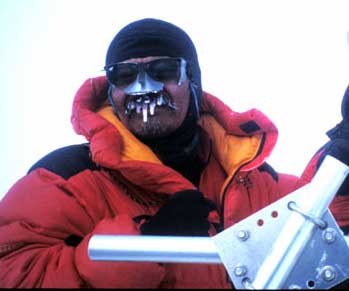 by Ned Rozell May 27, 2004
Okura, 53, lives in Japan but travels to Alaska each summer to climb Mt. McKinley with a team of young climbers from Japan and a few Americans who assist with repair and maintenance of the weather station. The weather station, six aluminum poles bolted together to provide perches for weather instruments, sits above Denali Pass in perhaps one of the windiest places on Earth. "There's certainly bursts of 100 miles per hour plus winds that go through that pass," said Roger Robinson, chief mountaineering ranger for Denali National Park. The weather station recorded an unofficial wind speed of 188 miles per hour three days before it stopped working in January 2003. When Okura and a climbing team took the West Buttress route to the station in 2003, they found that a whip antenna was missing. Okura and a team climbed back up the mountain's West Buttress route with replacement equipment in June 2003, but the equipment stopped transmitting to a satellite a few minutes after its installation. Though Okura and another team member returned to the station to check cable connections, the station still failed to transmit. This June, Kevin Abnett, the supervisor of the electronics shop at UAF's Geophysical Institute, will join Okura's team on the climb to repair the station. Abnett designed previous configurations of the weather station, which now includes an ultrasonic wind gauge with no moving parts, a thermometer, and a humidity sensor. The station will also use batteries and a transmitter to send data back to the International Arctic Research Center via satellite. Tohru Saito of the International Arctic Research Center is also joining the team for his third consecutive summer. The team approaches the task of working on the weather station as any group of climbers attempting Mt. McKinley's West Buttress route. They plan to take an air taxi from Talkeetna to the southwest fork of Kahiltna Glacier where the Park Service maintains a base camp at 7,300 feet. Team members will then spend three weeks on the mountain climbing, acclimatizing to the high altitude, and waiting out storms. Their last camp before reaching the weather station is at about 17,000 feet near Denali Pass. Since the weather station is located just off the West Buttress climbing route at 18,733 feet, team members will leave from the 17,000-foot "high camp" on a nice day, reach the weather station, and install new components while removing others to carry down. When the work is complete, team members who feel up to the challenge will attempt to reach the 20,320-foot summit, which is a few hours' climb from the weather station. Okura installed the weather station on the ridge above Denali Pass in 1990 because he believes three of his countrymen disappeared there while attempting a winter climb in February 1989. They may have been blown off the mountain, he said, which also may have been the fate of Japanese adventurer Naomi Uemura, who vanished while attempting to climb the mountain solo in February 1984. Though fierce winds have battered the weather instruments each winter, with the help of the International Arctic Research Center Okura has persevered in his quest to find a combination of weather instruments that will endure on the high ridge and transmit information to the Internet. "He has a keen interest
in what happens with the weather up there," Roger Robinson
said, adding that Okura has stood on the summit of North America's
tallest mountain more times than any other Japanese climber.
This column is provided as
a public service by the Geophysical Institute, University of
Alaska Fairbanks, in cooperation with the UAF research community.
Ned Rozell (e-mail) is
a science writer at the institute.
|
||
